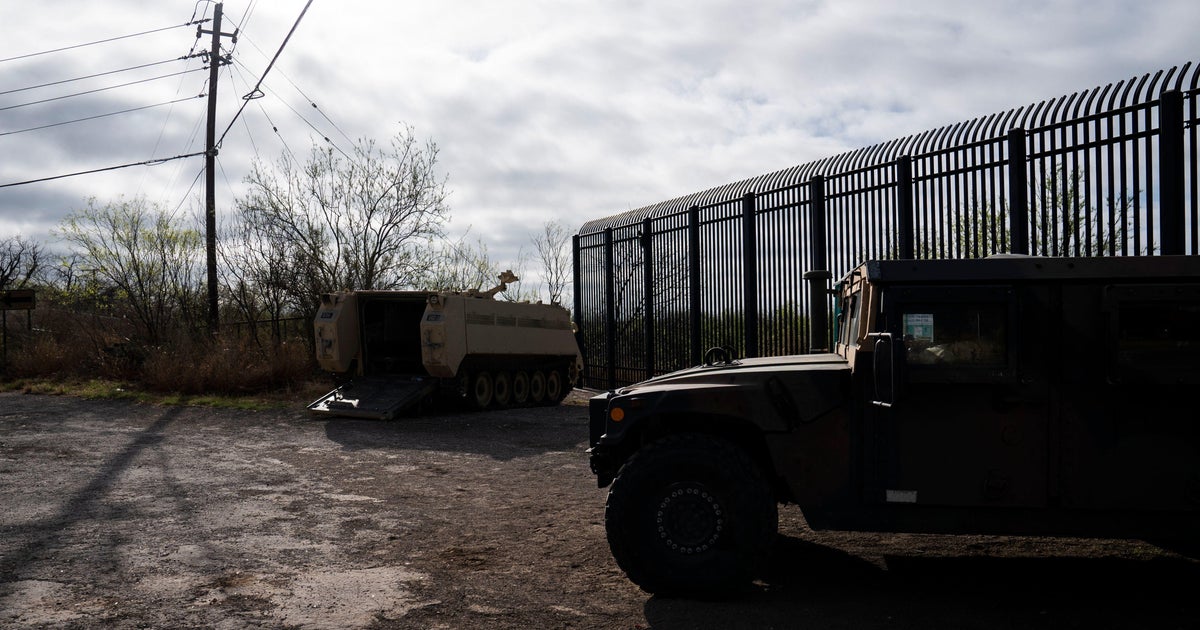Who qualifies for U.S. asylum and how does the process work?
Asylum and questions about who should be granted humanitarian protection have become focal points of the contentious debate over U.S. immigration policy and how the government should respond to unprecedented levels of migrant arrivals at the southern border.
During the COVID-19 pandemic, asylum processing along the U.S.-Mexico border has been partially suspended because of an emergency measure known as Title 42. But some migrants are being allowed to seek asylum. Other migrants don't seek asylum at all. And not all asylum-seekers enter through the southern border.
While a federal judge has blocked the Biden administration from lifting Title 42 for now, the challenges the U.S. asylum system has faced for years — from a massive backlog of applications and years-long processing times, to inconsistent policies and operational constraints — have continued to intensify.
The Biden administration this week started enforcing a rule it hopes will reform the asylum system and speed up case processing. But the policy will start on a limited scale and its success remains an open question, given operational challenges, the pandemic, record migrant arrests and Republican-led lawsuits.
Here's what you need to know about the U.S. asylum system and the challenges it faces:
Who qualifies for U.S. asylum?
For decades, U.S. law has allowed the government to grant asylum to immigrants who suffered or have a well-founded fear of persecution in their home country because of their nationality, race, religion, political views or membership in a "particular social group."
The persecution must come from government authorities or someone the home country is unable or unwilling to control. Poverty, scarce economic opportunities, displacement caused by natural disasters or a desire to reunite with family are not grounds for asylum under U.S. law.
While it uses the same legal threshold, refugee status is offered to individuals abroad. Asylum, on the other hand, is only available to those on U.S. soil. Barring some exceptions, U.S. law allows migrants in the U.S., including those who entered the country unlawfully, to request asylum as a means to halt their deportation.
How does the asylum process work?
There are two types of asylum cases: "defensive" and "affirmative" requests.
Migrants the government seeks to deport, including those who cross the U.S.-Mexico border illegally, can file defensive asylum applications to try to prevent their deportation. These cases are decided by immigration judges at the Justice Department, which also oversees an appellate immigration court body.
Immigrants with temporary legal status in the U.S., such as short-term visa holders, and unaccompanied children who enter U.S. border custody without their parents, can submit affirmative asylum applications with U.S. Citizenship and Immigration Services (USCIS).
While migrants seeking defensive asylum must make their case in adversarial court hearings that feature judges and government prosecutors, those with affirmative applications are interviewed by USCIS asylum officers.
Applicants whose asylum requests are denied by immigration judges can be ordered deported, though they can appeal those decisions. Asylum-seekers rejected by USCIS are typically placed in deportation proceedings and their cases are transferred to the immigration court system for a final decision.
Immigrants who are granted asylum by an immigration judge or USCIS are allowed to stay in the U.S. permanently and can request a green card one year after the decision. Their children and spouses are also allowed to come to and live in the U.S. legally.
Are people arriving at the U.S.-Mexico border currently allowed to seek asylum?
It depends. For the past two years, U.S. border officials have used the Title 42 public health authority to quickly expel migrants to Mexico or their home country without allowing them to request asylum.
Since the Trump administration invoked Title 42 in March 2020, migrants have been expelled over 1.9 million times from the southern border, Department of Homeland Security (DHS) data show.
However, not all migrants who enter U.S. border custody are expelled under Title 42, which is mainly used on single adults. The Biden administration, for example, has exempted certain groups from Title 42 on humanitarian grounds, including unaccompanied children, Ukrainian refugees and some asylum-seekers.
Other migrants are not expelled because of different reasons, including restrictions imposed by Mexico on who can be expelled there, operational challenges and strained diplomatic relations with countries like Cuba, Nicaragua and Venezuela that restrict or ban U.S. deportations.
Migrants who are processed under regular immigration procedures are allowed to seek asylum, and are either transferred to shelters or long-term detention facilities, released with a court notice or quickly deported directly from the southern border under a process known as expedited removal.
Those placed in expedited removal proceedings are only allowed to seek asylum if they establish credible fear of persecution during screenings with USCIS officers.
Why is the asylum system broken?
For years, liberals and conservatives have said the U.S. asylum system is broken, though they have offered different solutions to fix it.
Conservatives have said the asylum system is abused by economic migrants who use it to stay and work in the U.S. indefinitely, which they say encourages illegal immigration. Liberals have also criticized the delays in deciding asylum cases, saying they place legitimate asylum-seekers in a years-long legal limbo.
What is undeniably true is that a backlog of hundreds of thousands of unresolved cases has crippled the government's ability to decide asylum cases in a timely manner — and the years-long processing delays have worsened during the COVID-19 pandemic, which curtailed in-person court hearings and USCIS interviews.
At the start of 2022, the immigration court system had 628,551 pending asylum applications, Justice Department data show. In total, the immigration court system has over 1.6 million pending cases. USCIS, meanwhile, was overseeing 432,341 unresolved asylum requests at the start of 2022, agency statistics show.
The Justice Department currently has 578 immigration judges, while USCIS has 750 asylum officers. The Biden administration has said it plans to hire additional immigration judges and asylum officers, but the hiring process is slow.
Because of the massive backlog, immigrants wait an average of 1,621 days — or more than 4 years — for a hearing in immigration court, according to an analysis of government data by Syracuse University's TRAC program. While USCIS has a goal of adjudicating affirmative asylum requests within six months, most cases exceed that timeframe, agency data show.
How many applicants are granted asylum?
Unlike refugee admissions, which are capped every fiscal year by the president, there's no limit on the number of asylum requests the government can grant every year.
In fiscal year 2021, immigration judges approved 7,359 asylum requests and rejected 14,117 cases. During the first six months of fiscal year 2022, 8,494 asylum applications were approved by judges, while 9,738 were denied, Justice Department figures show.
USCIS granted asylum 7,118 times in fiscal year 2021, while rejecting 17,888 cases, agency data show. During the first three months of fiscal year 2022, USCIS approved 2,175 asylum requests and denied 9,727 cases.
Overall, asylum grant rates in immigration court have hovered around or below 20% since 2015. But the rates vary depending on the region the case is filed in, the applicant's nationality, the variables used in the calculations and access to legal representation, or lack thereof, government statistics show.
A 2020 DHS report found that 89% of the court cases of Central American migrant families who crossed the U.S.-Mexico border between fiscal years 2014 and 2019 remained unresolved.
How has asylum policy changed under Biden?
Through multiple regulations and international deals, the Trump administration limited asylum eligibility and allowed border officials to quickly deport migrants or require them to wait in Mexico for their hearings.
Soon after taking office, President Biden suspended some Trump asylum restrictions, including the so-called "Remain in Mexico" program and deals that allowed the U.S. to reroute asylum-seekers to Guatemala, Honduras and El Salvador with instructions to seek protection there.
The Biden administration, however, kept Title 42 in place, defending it as a public health policy for over a year. While it made exceptions to the expulsions, the Biden administration has used Title 42 longer and more often than the Trump administration, carrying out over 1.4 million migrant expulsions in its first 15 months.
Last year, the Biden administration revoked a Trump policy that generally disqualified victims of domestic and gang violence from asylum and said it would issue a regulation to define the "particular social group" ground for asylum that has been contested for decades. The rule has yet to be finalized.
How can the system be fixed?
Conservatives have proposed narrowing asylum eligibility, detaining asylum-seekers while their cases are reviewed and ramping up deportations. Liberals, meanwhile, have advocated for connecting asylum-seekers with lawyers, hiring additional asylum officers and speeding up case processing.
The Biden administration's attempt to overhaul asylum processing along the southern border aligns with the latter approach. It is designed to accelerate adjudications by assigning USCIS officers to decide asylum cases, rather than funneling all requests to the backlogged immigration courts.
But it remains to be seen whether officials will be able to hire enough asylum officers and allocate sufficient resources, including deportation flights for those whose cases are rejected, for the rule to achieve its objective of delivering more expeditious asylum grants or denials. The rule could also be blocked in court.
Recognizing that many migrants who travel to the U.S.-Mexico border do not ask for asylum or do not qualify for it, experts have also suggested expanding legal immigration, such as work and family-based visas, to allow would-be migrants to come to the country legally and thus reduce pressure on the asylum system.
"Asylum is not going to solve everything at the border. Many of these people just want to come to work. If we need people in this country to work, they should be able to come legally and they should also not compromise our asylum system," said Muzaffar Chishti, a senior fellow at the Migration Policy Institute.
At the same time, Chishti said, the U.S. needs to find durable solutions to the challenges plaguing its asylum system to ensure it's providing refuge to those fleeing persecution, in accordance with U.S. and international refugee law.
"Our asylum system doesn't serve anyone," Chishti said. "It doesn't serve people who deserve to get it because we don't give it to them for years, and it doesn't remove people from the country who don't deserve it."




